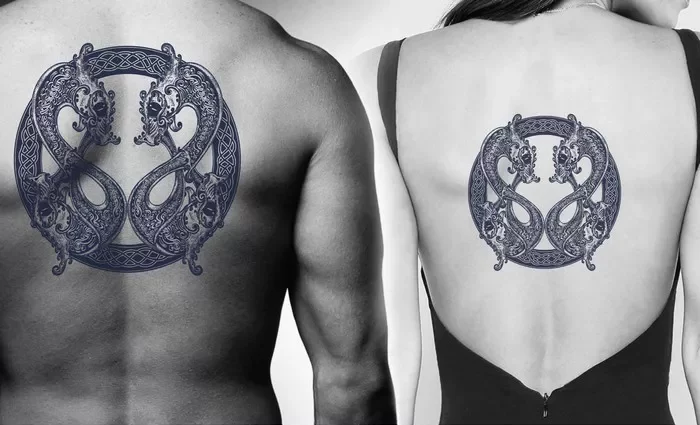Dragon tattoos are among the most revered and intricately designed body art in Asia. Rooted in ancient mythology and culture, these tattoos carry deep meanings that vary from country to country. In this article, we will explore the significance of dragon tattoos in various Asian cultures, including Chinese, Japanese, Korean, and Southeast Asian traditions. Understanding these meanings not only enriches the appreciation of the art form but also highlights the cultural heritage that shapes these powerful symbols.
The Dragon in Asian Mythology
The Symbol of the Dragon
In many Asian cultures, the dragon is a symbol of power, strength, and good fortune. Unlike Western depictions, which often portray dragons as malevolent creatures, Asian dragons are predominantly seen as benevolent beings associated with water, agriculture, and fertility. They are considered protectors and bringers of prosperity, embodying the ideal balance between nature and humanity.
Cultural Significance Across Asia
1. Chinese Culture
In China, the dragon (龙, lóng) is one of the most significant symbols. It is associated with the emperor and the imperial family, representing sovereignty and authority. The Chinese dragon is often depicted as a long, serpentine creature with antler-like horns, resembling a mix of different animals.
Symbol of Power: Historically, the dragon was the emblem of the emperor, symbolizing his divine right to rule. Dragon motifs adorned imperial robes and architecture.
Fertility and Rain: Dragons are also associated with water and rain, vital for agriculture. They are believed to control rivers, lakes, and seas, making them essential for a prosperous harvest.
Good Luck and Prosperity: Many Chinese people believe that having a dragon tattoo can attract good fortune and success.
2. Japanese Culture
In Japan, the dragon (ドラゴン, doragon) is often linked to water and agriculture, much like its Chinese counterpart. However, Japanese dragons are typically depicted with three claws, distinguishing them from Chinese dragons, which usually have four.
Guardian Spirits: Japanese dragons are often seen as protectors, associated with temples and sacred sites. They are believed to ward off evil spirits and bring blessings.
Transformation and Rebirth: The dragon is a symbol of transformation. In Japanese folklore, dragons are said to have the ability to transform into other forms, representing the cycle of life and rebirth.
Balance of Forces: The dragon embodies the balance between human ambition and nature, teaching respect for the environment.
3. Korean Culture
In Korea, dragons (용, yong) are also considered auspicious beings, linked closely to water and agricultural prosperity. They are often depicted with a long, slender body and a friendly demeanor.
Symbol of Authority: Korean kings and rulers were often compared to dragons, representing their strength and noble lineage.
Cultural Heritage: The Korean dragon is associated with shamanistic beliefs and is seen as a protector of the country. It is a symbol of national pride and cultural identity.
Luck and Protection: Many Koreans believe that dragon tattoos can bring luck and shield the wearer from misfortune.
4. Southeast Asian Culture
In various Southeast Asian cultures, dragon imagery appears in diverse forms, often blending local mythology with Hindu and Buddhist influences.
Naga: In countries like Thailand, Laos, and Cambodia, dragons are often represented as Naga—serpent-like beings associated with water and fertility. They are protectors of the land and are believed to bring rain and prosperity.
Cultural Symbols: Dragon tattoos in Southeast Asia may symbolize courage, strength, and protection, often representing the wearer’s connection to their cultural heritage.
Buddhism and Hinduism: Dragons are depicted in many Buddhist and Hindu artworks, symbolizing wisdom and protection on the spiritual journey.
The Artistic Representation of Dragon Tattoos
Design Elements
Dragon tattoos can vary significantly in design, reflecting the rich cultural heritage and artistic styles of different regions.
Color Palette: In Chinese culture, colors like red and gold are commonly used, symbolizing luck and prosperity. In contrast, Japanese dragons may feature blues and greens, representing water and nature.
Stylistic Differences: The design can be intricate and detailed, with swirling clouds, waves, and fire. Each region has its unique style, influenced by local art forms.
Size and Placement
Dragon tattoos can be placed on various body parts, with larger designs often adorning the back, chest, or arms. The size and placement can affect the tattoo’s visibility and personal significance.
Cultural Context: In some cultures, certain placements may hold more significance. For instance, a dragon tattoo on the arm can symbolize strength and bravery, while one on the back may represent protection.
Personal Interpretations of Dragon Tattoos
Individual Meaning
While dragon tattoos carry cultural significance, they can also hold personal meaning for the wearer. Some may choose a dragon tattoo to symbolize resilience, transformation, or personal strength.
Empowerment: For many, a dragon tattoo represents overcoming challenges and embracing their inner strength.
Cultural Connection: Individuals of Asian descent may choose a dragon tattoo as a way to honor their heritage and connect with their cultural roots.
Stories and Experiences
Each dragon tattoo tells a story. The choice of design, size, and placement often reflects personal experiences and beliefs, making each tattoo unique.
Symbol of Change: Some individuals get dragon tattoos during significant life transitions, marking a journey of personal growth and transformation.
Commemoration: For others, a dragon tattoo may serve as a tribute to loved ones or a significant life event, representing strength and protection.
Conclusion
Dragon tattoos are a powerful expression of cultural identity and personal meaning across Asia. They embody deep-rooted beliefs in strength, protection, and prosperity, resonating with individuals on multiple levels. By understanding the meanings behind dragon tattoos in various Asian cultures, we can appreciate their beauty and significance more profoundly.
Whether as a symbol of power, a tribute to heritage, or a marker of personal transformation, dragon tattoos continue to inspire and captivate people around the world. As this art form evolves, it remains a timeless representation of the rich cultural tapestry that shapes our understanding of identity and expression.
Related topics:

